
Eddy’s HR Mavericks Encyclopedia
The world's largest free encyclopedia of HR, with 700+ HR articles and podcasts.
Created by Eddy and our HR Mavericks community.
DISC Personality Assessments
DISC personality style assessments are an excellent way to improve numerous aspects of workplace culture by encouraging self-awareness and social awareness in your workforce. Self-aware employees find themselves tapping into natural talents more frequently. At the same time, a socially aware workforce decreases the propensity for conflict while increasing job satisfaction company-wide.
Why Use Personality Tests?
A personality test as it applies to the workplace is an assessment used to create self-awareness within oneself, with the goal of being able to self-evaluate more effectively and become more productive as a result.
What Is DISC?
The idea of DISC (Dominance, Inducement, Submission, and Compliance) came to prominence in 1928 when William Marston tied the acronym to identifying distinct behaviors inherent in the four personality styles. In modern times, Merrick Rosenburg improved the deliverability and neurological retention of the four styles by relating the four styles to four birds, creating visual cues that enhance the ability to remember and apply the styles appropriately. Since Rosenberg’s take on DISC, the four styles have been reintroduced as Dominant, Interactive, Supportive, and Conscientious. Each style has its own set of natural talents, areas of development and potential overuses. Unlike the majority of other personality assessments, DISC tends to emphasize the effect of one’s personality at work as well as at home, and attempts to consolidate the two so that work/life balance can truly be achieved. In the workplace, DISC is used to create self-awareness in individual employees, allowing them to more effectively tap into their natural talents and be more open to areas of development. Once self-awareness is achieved, social awareness is then promoted to flex our styles to meet others in a way that best communicates with and serves them. The end result of all of this tends to be higher job satisfaction, greater productivity, and higher retention in the organization itself.
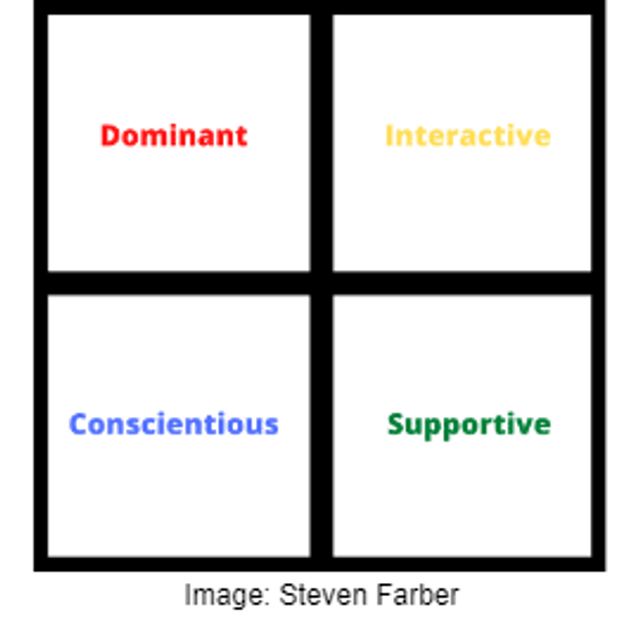
Use and Efficacy
While there are many quadrant-based personality modules, there is good evidence that DISC is the most accurate and reliable among them, as determined in a study involving nearly 29,000 respondents on the efficacy of DISC’s specific use of the quadrant module by Carl Jung. Because the success of all self-report type assessments depends on the insight, candor, and honesty of the assessment-taker, it’s important that the format be as accurate as possible. Feel free to use the following link to dig into the nuts and bolts of how the researchers in the mentioned study came to the conclusion that they did.
Visual Application of DISC Styles
Given that the majority (65%) of people are visual learners, Merrick Rosenburg's created arguably the most popular and effective implementation method when he related the four styles to birds (according to the validation study cited above). A quick Google search of DISC with animals will turn up all kinds of representations of the four styles, such as lions representing the Dominance trait, peacocks the Interactive trait, and so on. Visual representation seems to have been the missing link for creating a stickiness with DISC so that the valuable information learned stays with the employee and impacts the workforce long after the initial assessments have been performed.
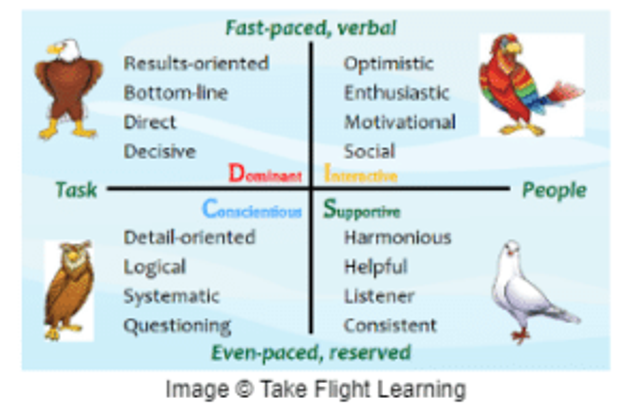
Identifying the Four Styles
The four personality styles are relatively easy to spot. We constantly exude our personality styles, and understanding what to look for in ourselves is step one in creating a better work culture. To assist in your retention of the styles, I will refer to the styles as their bird counterparts according to Rosenburg’s system. (The four bird images are used with permission © Take Flight Learning .)
(D) Dominant Style: Eagle
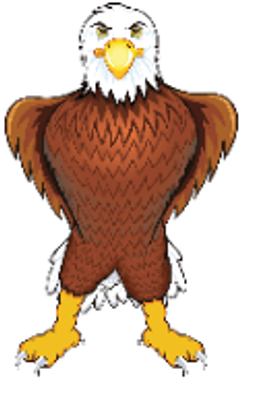
Eagles are the Dominant (D) style. Eagles are driven to achieve their goals, and the more ambitious they are, the better. Eagles want to cut to the chase and make progress quickly, always getting things done. In other words, it's all about results. Eagles fly high over the forest and take in everything. They see the world from a 10,000-foot view, and when they spot a rodent or a fish, they don't stop to ask a committee about it; they act immediately. They let out a screech to tell other birds, “Look out, I’m coming through!” as they swoop in and get what they want. They tend to be pretty solitary unless you see them with a mate.
(I) Interactive Style: Parrot
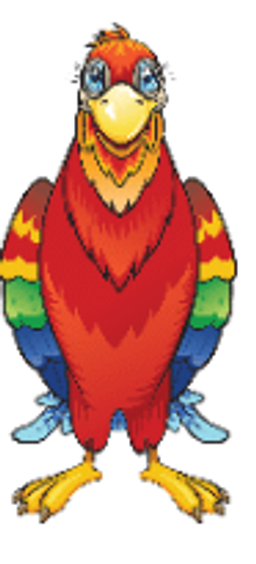
Parrots represent the Interactive (I) style. Parrots are very approachable, optimistic, and social. They are usually upbeat, and their energy can be contagious and motivating to others. Their enthusiasm for fresh experiences makes them receptive to new ideas and innovations. Parrots have a love of life that never goes away. They get excited about everything. A Parrot eating a sandwich says, “This is the greatest sandwich ever!” You look at them and say, “Um, that’s just a peanut butter and jelly sandwich.” They don’t literally mean it’s the greatest sandwich ever; they’re just hungry and enjoying their food. Real parrots travel in large flocks that make tons of noise. Our personality-style parrots can also be loud, as they are talkative, social, and enthusiastic.
(S) Supportive Style: Dove
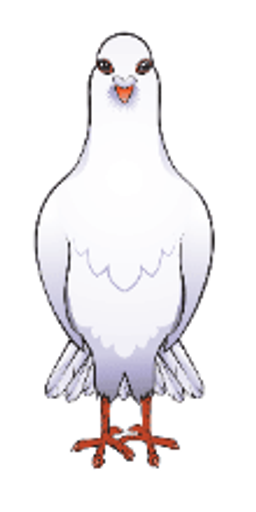
Doves represent the Supportive (S) style. They get along with most people, and they are helpful. Doves are good listeners and have lots of patience, which allows them to have a calming effect in most situations. They excel at making people feel welcome and comfortable. Doves are deliberate, systematic, and like to maintain the status quo. Settings that are steady, stable, and predictable create safety for them, as they feel they know how to behave in those situations. Doves are also flock animals. We can see large groups of them just about anywhere. But the noise they make is very different from parrots. Doves emit a soft cooing sound, and the message is, Come join me. I found food.
(C) Conscientious Style: Owl
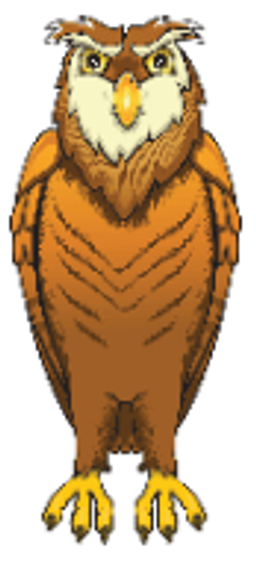
Owls represent the Conscientious (C) style. Owls are driven to achieve accuracy. They start by collecting as much data as they can, and then systematically organize and analyze it to arrive at a logical conclusion. For the Owl, quality is a top priority because if you’re going to do something, you might as well do it right. Otherwise, you’re going to have to do it again. As in life, our Owls like to work behind the scenes and don’t crave attention like the Parrots. Owls are known as silent night hunters. You don’t see flocks of owls flying around. If you see them at all, they’re solitary, like the eagle, or maybe in a mated pair. For Owls, getting quality results means having a plan, focusing, and following proper procedures.
Benefits of a DISC Assessment
There are many benefits to DISC assessments in the workplace. Here are just a few.
Self Awareness
In the context of DISC, self-awareness means understanding our personality style, natural strengths and talents, and where our areas of development lie. Understanding how you think, your preferred communication style, your work setting, and how you like to receive feedback is pivotal for allowing you to be your best self at work. When you understand yourself, you can be yourself at work, which is something you probably have been avoiding for one reason or another. Being yourself at work opens up doors to productivity and job satisfaction like never before.
Social Awareness
Social awareness is the understanding that other people have their own styles, and not everyone sees things the same way you do. Furthermore, it's impossible to flex and meet the needs of others if you aren't aware of other styles. Luckily, social awareness is easy to grasp once self-awareness has been reached, and you'll often be able to identify the styles of others within minutes of meeting them. Identification is pivotal to style flexibility.
Style Flexibility
Style flexibility is a little like the golden rule taken in a different direction. We've all been taught to treat others the way we want to be treated, and that rings true for style-agnostic qualities like kindness, honesty, and the like. However, when we take this idea to the workplace—and indeed beyond—it makes sense to adopt something called the home rule, or platinum rule, as it's sometimes called. We use the term home rule because we aren't trying to out-shine the golden rule; we are simply adjusting to our preferred home base communication style.
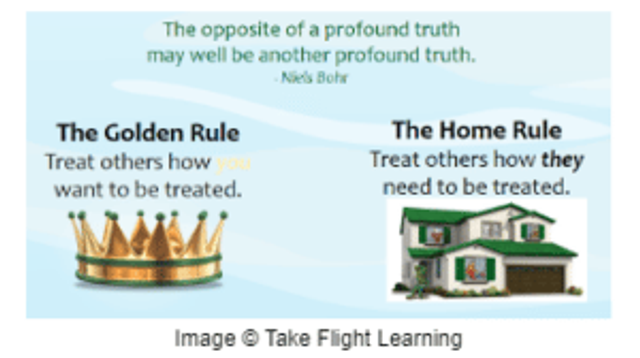
Style flexing is the ability to flex to meet the communication style of others. This allows you to adapt to meet the needs of others and act and communicate appropriately per their style. Feedback and acknowledgment are style-dependent, and may not be appropriate or received unless style flexing is implemented. (This is especially valuable for managers to understand.)
Outcomes of DISC Assessments
When properly implemented, the following outcomes of DISC personality testing can be expected by both employees and employers.
Employee Outcomes
- A deep understanding of their own personality style
- The ability to quickly read the styles of others and instantly flex to meet their needs
- Tap into their natural gifts to capitalize on their strengths
- Avoid overusing their strengths so they don’t become liabilities
- Infuse the four styles into their organizational culture so they are used every day
- Build stronger relationships, communicate more effectively, become empowering leaders, and co-create a more engaging and productive work environment
Employer Outcomes
- Higher productivity. Employees who understand themselves and others work cooperatively and swiftly to achieve their objectives.
- Greater job satisfaction. The four styles generate enthusiasm, foster a positive atmosphere, and allow people to achieve success with passion and enthusiasm.
- Greater employee engagement. Team cohesion, conflict mitigation, openness, and employee loyalty are all enhanced. Through awareness of the four styles, individuals are able to communicate clearly, collaborate effectively, and inspire excellence.
- Higher employee retention. When employees are happy, productive, and open to communication, retention naturally follows. The organization becomes more than just a “job” and instead begins to become a place of growth and acceptance.
How to Implement DISC in the Workplace
To be clear, DISC is owned by no one in particular, and you can easily find many free resources for it, from questionnaires to stylized representations of the four styles. However, it’s probably in your best interest to contact a provider to ensure that implementation is both cost- and culture-effective. Because no one owns DISC, various organizations have various certifications and levels of testing. Not all of them reflect the value you need to apply to your workplace. Thus, regardless of who you decide to go with, or if you intend to go at it alone, you need to ensure that along with self-awareness, social awareness, and flexibility, long-term viability is considered as well to ensure the best return on investment.
Long-Term Viability
One complaint often brought up in the face of any personality assessment program is the long-term effectiveness of the program itself. The ability to resonate with your workplace culture long-term isn't always achieved unless self-and social awareness have been adequately taught in a way that resonates with everyone. Fortunately, personality style training is relatable to everyone. DISC programs can achieve long-term effects by implementing visual, relatable style monikers such as birds mentioned above. When looking for DISC assessment providers, look for modules that follow Rosenburg's approach to ensure maximum neurological retention.
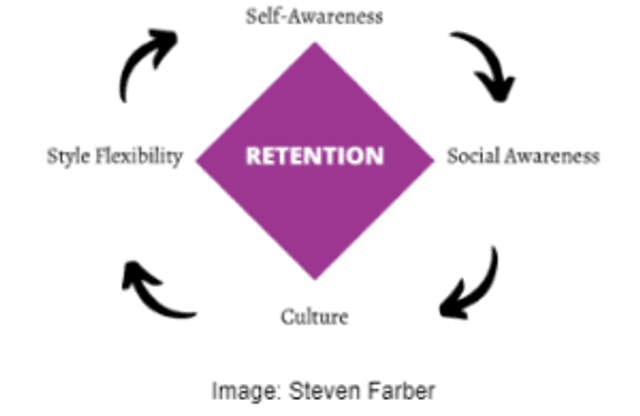
Topics

Steven Farber
I spent much of my working life in a whirlwind of uncertainty wondering when I would find a career that would make me happy. After spending 23 years trying to find that 'dream career' I came to a sobering conclusion. I realized that I wasn't looking for a career, but for a purpose and that I would never be happy until I figured out what that purpose was. After a long hard road of trial and error, I concluded that my purpose, the very activity that brought me happiness was when I could bring that happiness to others first. Removing the vast amounts of uncertainty this life can bring for others and replacing it with true peace of mind, gave me my much sought-after peace of mind.
Frequently asked questions
Other Related Terms
Eddy’s HR Mavericks Encyclopedia
DISC Personality Assessments
DISC personality style assessments are an excellent way to improve numerous aspects of workplace culture by encouraging self-awareness and social awareness in your workforce. Self-aware employees find themselves tapping into natural talents more frequently. At the same time, a socially aware workforce decreases the propensity for conflict while increasing job satisfaction company-wide.
Why Use Personality Tests?
A personality test as it applies to the workplace is an assessment used to create self-awareness within oneself, with the goal of being able to self-evaluate more effectively and become more productive as a result.
What Is DISC?
The idea of DISC (Dominance, Inducement, Submission, and Compliance) came to prominence in 1928 when William Marston tied the acronym to identifying distinct behaviors inherent in the four personality styles. In modern times, Merrick Rosenburg improved the deliverability and neurological retention of the four styles by relating the four styles to four birds, creating visual cues that enhance the ability to remember and apply the styles appropriately. Since Rosenberg’s take on DISC, the four styles have been reintroduced as Dominant, Interactive, Supportive, and Conscientious. Each style has its own set of natural talents, areas of development and potential overuses. Unlike the majority of other personality assessments, DISC tends to emphasize the effect of one’s personality at work as well as at home, and attempts to consolidate the two so that work/life balance can truly be achieved. In the workplace, DISC is used to create self-awareness in individual employees, allowing them to more effectively tap into their natural talents and be more open to areas of development. Once self-awareness is achieved, social awareness is then promoted to flex our styles to meet others in a way that best communicates with and serves them. The end result of all of this tends to be higher job satisfaction, greater productivity, and higher retention in the organization itself.

Use and Efficacy
While there are many quadrant-based personality modules, there is good evidence that DISC is the most accurate and reliable among them, as determined in a study involving nearly 29,000 respondents on the efficacy of DISC’s specific use of the quadrant module by Carl Jung. Because the success of all self-report type assessments depends on the insight, candor, and honesty of the assessment-taker, it’s important that the format be as accurate as possible. Feel free to use the following link to dig into the nuts and bolts of how the researchers in the mentioned study came to the conclusion that they did.
Visual Application of DISC Styles
Given that the majority (65%) of people are visual learners, Merrick Rosenburg's created arguably the most popular and effective implementation method when he related the four styles to birds (according to the validation study cited above). A quick Google search of DISC with animals will turn up all kinds of representations of the four styles, such as lions representing the Dominance trait, peacocks the Interactive trait, and so on. Visual representation seems to have been the missing link for creating a stickiness with DISC so that the valuable information learned stays with the employee and impacts the workforce long after the initial assessments have been performed.

Identifying the Four Styles
The four personality styles are relatively easy to spot. We constantly exude our personality styles, and understanding what to look for in ourselves is step one in creating a better work culture. To assist in your retention of the styles, I will refer to the styles as their bird counterparts according to Rosenburg’s system. (The four bird images are used with permission © Take Flight Learning .)
(D) Dominant Style: Eagle

Eagles are the Dominant (D) style. Eagles are driven to achieve their goals, and the more ambitious they are, the better. Eagles want to cut to the chase and make progress quickly, always getting things done. In other words, it's all about results. Eagles fly high over the forest and take in everything. They see the world from a 10,000-foot view, and when they spot a rodent or a fish, they don't stop to ask a committee about it; they act immediately. They let out a screech to tell other birds, “Look out, I’m coming through!” as they swoop in and get what they want. They tend to be pretty solitary unless you see them with a mate.
(I) Interactive Style: Parrot

Parrots represent the Interactive (I) style. Parrots are very approachable, optimistic, and social. They are usually upbeat, and their energy can be contagious and motivating to others. Their enthusiasm for fresh experiences makes them receptive to new ideas and innovations. Parrots have a love of life that never goes away. They get excited about everything. A Parrot eating a sandwich says, “This is the greatest sandwich ever!” You look at them and say, “Um, that’s just a peanut butter and jelly sandwich.” They don’t literally mean it’s the greatest sandwich ever; they’re just hungry and enjoying their food. Real parrots travel in large flocks that make tons of noise. Our personality-style parrots can also be loud, as they are talkative, social, and enthusiastic.
(S) Supportive Style: Dove

Doves represent the Supportive (S) style. They get along with most people, and they are helpful. Doves are good listeners and have lots of patience, which allows them to have a calming effect in most situations. They excel at making people feel welcome and comfortable. Doves are deliberate, systematic, and like to maintain the status quo. Settings that are steady, stable, and predictable create safety for them, as they feel they know how to behave in those situations. Doves are also flock animals. We can see large groups of them just about anywhere. But the noise they make is very different from parrots. Doves emit a soft cooing sound, and the message is, Come join me. I found food.
(C) Conscientious Style: Owl

Owls represent the Conscientious (C) style. Owls are driven to achieve accuracy. They start by collecting as much data as they can, and then systematically organize and analyze it to arrive at a logical conclusion. For the Owl, quality is a top priority because if you’re going to do something, you might as well do it right. Otherwise, you’re going to have to do it again. As in life, our Owls like to work behind the scenes and don’t crave attention like the Parrots. Owls are known as silent night hunters. You don’t see flocks of owls flying around. If you see them at all, they’re solitary, like the eagle, or maybe in a mated pair. For Owls, getting quality results means having a plan, focusing, and following proper procedures.
Benefits of a DISC Assessment
There are many benefits to DISC assessments in the workplace. Here are just a few.
Self Awareness
In the context of DISC, self-awareness means understanding our personality style, natural strengths and talents, and where our areas of development lie. Understanding how you think, your preferred communication style, your work setting, and how you like to receive feedback is pivotal for allowing you to be your best self at work. When you understand yourself, you can be yourself at work, which is something you probably have been avoiding for one reason or another. Being yourself at work opens up doors to productivity and job satisfaction like never before.
Social Awareness
Social awareness is the understanding that other people have their own styles, and not everyone sees things the same way you do. Furthermore, it's impossible to flex and meet the needs of others if you aren't aware of other styles. Luckily, social awareness is easy to grasp once self-awareness has been reached, and you'll often be able to identify the styles of others within minutes of meeting them. Identification is pivotal to style flexibility.
Style Flexibility
Style flexibility is a little like the golden rule taken in a different direction. We've all been taught to treat others the way we want to be treated, and that rings true for style-agnostic qualities like kindness, honesty, and the like. However, when we take this idea to the workplace—and indeed beyond—it makes sense to adopt something called the home rule, or platinum rule, as it's sometimes called. We use the term home rule because we aren't trying to out-shine the golden rule; we are simply adjusting to our preferred home base communication style.

Style flexing is the ability to flex to meet the communication style of others. This allows you to adapt to meet the needs of others and act and communicate appropriately per their style. Feedback and acknowledgment are style-dependent, and may not be appropriate or received unless style flexing is implemented. (This is especially valuable for managers to understand.)
Outcomes of DISC Assessments
When properly implemented, the following outcomes of DISC personality testing can be expected by both employees and employers.
Employee Outcomes
- A deep understanding of their own personality style
- The ability to quickly read the styles of others and instantly flex to meet their needs
- Tap into their natural gifts to capitalize on their strengths
- Avoid overusing their strengths so they don’t become liabilities
- Infuse the four styles into their organizational culture so they are used every day
- Build stronger relationships, communicate more effectively, become empowering leaders, and co-create a more engaging and productive work environment
Employer Outcomes
- Higher productivity. Employees who understand themselves and others work cooperatively and swiftly to achieve their objectives.
- Greater job satisfaction. The four styles generate enthusiasm, foster a positive atmosphere, and allow people to achieve success with passion and enthusiasm.
- Greater employee engagement. Team cohesion, conflict mitigation, openness, and employee loyalty are all enhanced. Through awareness of the four styles, individuals are able to communicate clearly, collaborate effectively, and inspire excellence.
- Higher employee retention. When employees are happy, productive, and open to communication, retention naturally follows. The organization becomes more than just a “job” and instead begins to become a place of growth and acceptance.
How to Implement DISC in the Workplace
To be clear, DISC is owned by no one in particular, and you can easily find many free resources for it, from questionnaires to stylized representations of the four styles. However, it’s probably in your best interest to contact a provider to ensure that implementation is both cost- and culture-effective. Because no one owns DISC, various organizations have various certifications and levels of testing. Not all of them reflect the value you need to apply to your workplace. Thus, regardless of who you decide to go with, or if you intend to go at it alone, you need to ensure that along with self-awareness, social awareness, and flexibility, long-term viability is considered as well to ensure the best return on investment.
Long-Term Viability
One complaint often brought up in the face of any personality assessment program is the long-term effectiveness of the program itself. The ability to resonate with your workplace culture long-term isn't always achieved unless self-and social awareness have been adequately taught in a way that resonates with everyone. Fortunately, personality style training is relatable to everyone. DISC programs can achieve long-term effects by implementing visual, relatable style monikers such as birds mentioned above. When looking for DISC assessment providers, look for modules that follow Rosenburg's approach to ensure maximum neurological retention.

Topics

Steven Farber
I spent much of my working life in a whirlwind of uncertainty wondering when I would find a career that would make me happy. After spending 23 years trying to find that 'dream career' I came to a sobering conclusion. I realized that I wasn't looking for a career, but for a purpose and that I would never be happy until I figured out what that purpose was. After a long hard road of trial and error, I concluded that my purpose, the very activity that brought me happiness was when I could bring that happiness to others first. Removing the vast amounts of uncertainty this life can bring for others and replacing it with true peace of mind, gave me my much sought-after peace of mind.
Frequently asked questions
Other Related Terms
Eddy's HR Newsletter
Sign up for our email newsletter for helpful HR advice and ideas.


